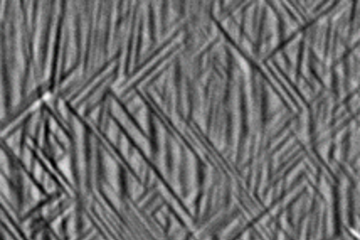All genres
361.
Talk
On the stability of residual austenite in low alloyed TRIP steels. 19th GLADD Meeting, UGent-KUL-RWTH-MPIE-TUDelft Workshop, Gent, Belgium (2012)
362.
Talk
Advanced analysis of 3D EBSD data obtained by FIB-EBSD tomography. European Microscopy Congress, Manchester, UK (2012)
363.
Talk
On the Reconstruction and Analysis of Interfaces in 3D-EBSD Datasets. RMS EBSD Meeting 2012, Teddington, UK (2012)
364.
Talk
Improving the Reliability of EBSD-based Texture Analysis by a New Large Area Mapping Technique. International Conference on the Textures of Materials, ICOTOM 16, Mumbai, India (2011)
365.
Talk
Advanced Methods and Tools for Reconstruction and Analysis of Grain Boundaries from 3D-EBSD Data Sets. International Conference on the Textures of Materials, ICOTOM 16, Bombay, India (2011)
366.
Talk
Comprehensive 5-parameter grain boundary description: How to measure it, how to display it and how important is it? ICOTOM 16, Mumbai, India (2011)
367.
Talk
Advanced Reconstruction and Analysis of Grain Boundaries from 3D-EBSD Data Sets. MRS Fall Meeting 2011, Boston, MA, USA (2011)
368.
Talk
Advanced Reconstruction and Analysis of Grain Boundaries from 3D-EBSD Data Sets. 3D Microstructure Meeting 2011, Saarbrücken, Germany (2011)
369.
Talk
The effect of rare earth elements on the mechanical properties of Mg - Theory and experiment. MagNET Workshop 6, Hamilton, ON, Canada (2011)
370.
Talk
Factors influencing the strain-induced transformation of residual austenite in a low-alloyed TRIP steel. Euromat 2011 Conference, Montpellier, France (2011)
371.
Talk
Detailed observation of martensite transformation and twinning in TRIP and TWIP steels using advanced SEM diffraction techniques. ICOMAT 2011, Osaka, Japan (2011)
372.
Talk
Electron diffraction-based techniques in the SEM: Do they give you everything you ever wanted to know about your sample? XIVth ICEM, Wisła, Poland (2011)
373.
Talk
Observation of the crystallographic defect structure in lightly deformed TWIP steel by means of electron channeling contrast imaging (ECCI). 1st International Conference on High Manganese Steels (HMnS2011), Seoul, South Korea (2011)
374.
Talk
Computational Crystal Plasticity. Korea Institute of Science and Technology (KIST), Seoul, South Korea (2011)
375.
Talk
Currents state of the art in EBSD: Possibilities and limitations. Seminar Talk at Ludwig-Maximilians-Universität, München, Germany (2011)
376.
Talk
Advanced applications of SEM-based diffraction techniques. IUMAS conference, Seoul, South Korea (2011)
377.
Talk
Deformation induced dislocation interactions near martensite-ferrite phase boundaries. MRS Fall Meeting 2011, San Francisco, CA, USA (2011)
378.
Talk
A new large-area mapping technique to improve the statistical reliability of EBSD datasets. Royal Microscopy Society (RMS) EBSD 2011 Meeting, Düsseldorf, Germany (2011)
379.
Talk
Advanced Tomographic Tools for Reconstruction and Analysis of 3D-EBSD Datasets. RMS Electron Back Scatter Diffraction Conference 2011, Düsseldorf, Germany (2011)
380.
Talk
Deformation-induced geometrically necessary dislocation evolution in dual-phase steel. 20th EBSD Conference, Düsseldorf, Germany (2011)











